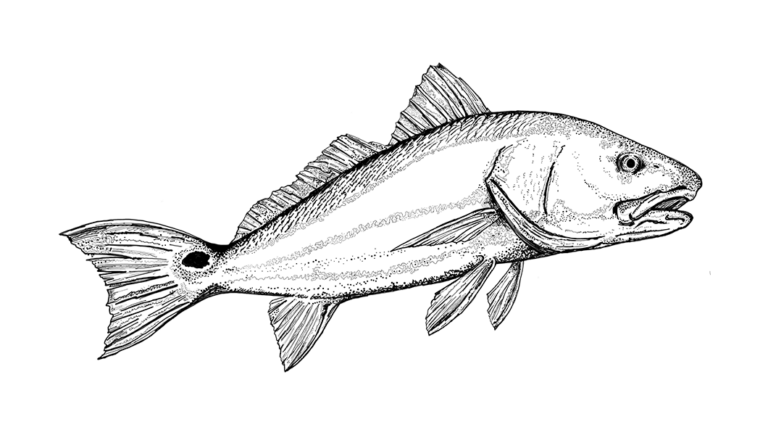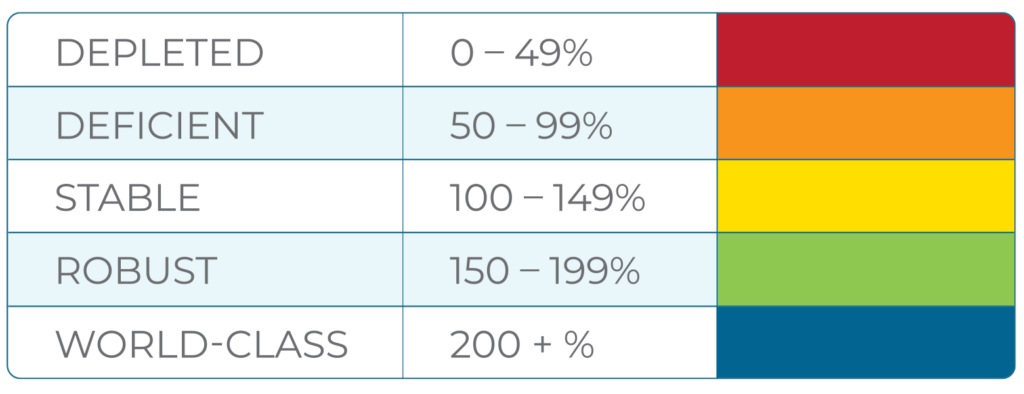Red Drum


126% = STABLE
How It’s Calculated
FINDEX is a novel way to gauge whether the status of a fish population is trending up or down. Management of most fish species in North Carolina is guided by stock assessment models developed by various groups of scientists. The calculations in our FINDEX metric measure the gap between the desired condition of a fish stock (the Target reference value) and the existing condition (the most recent data year in the model called the Terminal value) as determined in each stock assessment. The gaps between Target and Terminal values are reported as ratios.
For example, if the Target and Terminal values are the same, there would be no gap, and the ratio would be 1.0. The multiplier on our FINDEX barometer would set the FINDEX value at 100% in this example and assign a stock status designation of “Stable.” Categories on the FINDEX barometer are measurable as they track the extent of the gap either above or below the “Stable” designation.
For Red Drum, the FINDEX gap assessment compared Target and Terminal values of static Spawning Potential Ratio (sSPR) from the most recent stock assessment model developed by the Atlantic States Marine Fisheries Commission. The Target reference value used in the model was sSPR40% (0.40). The Terminal year in the stock assessment model was 2013. The model estimated sSPR in 2013 to be 0.504 for the “northern stock” of Red Drum which includes North Carolina.
Here's the FINDEX formula used for Red Drum:

- (0.504/0.40) x 100 = 126
- FINDEX = 126% for 2013
- 126% = STABLE

What Does Stable Mean?
Stable means the most recent stock conditions (2013 data in the case of Red Drum) have either met or exceeded the biological reference values established in the fishery management plan. FINDEX designation as “Stable” is assigned to any stock with a value reaching 100%. Note there is a considerable time lag associated with updates to stock assessments for most of North Carolina’s fisheries. Periods between updates are usually 5 years and sometimes 10+ years. For this reason, FINDEX calculations may not accurately describe current conditions – instead, FINDEX evaluates the most recent scientific data available.
FINDEX Stock Status Over Time
The stock assessment model for Red Drum provides point estimates of static Spawning Potential Ratio for each year covered in the data set. We’ve compared the Target reference values to these annual point estimates and calculated the ratios (gaps) for each data year from 1991–2013.
Applying the FINDEX gap assessment to the entire time series provides the following stock status trendline:
No Data Found
How Do We Get To World-Class?
FINDEX can also be used to determine when a population has reached “World-Class” status.
A Target value for static Spawning Potential Ratio has been established for Red Drum by the management agencies. Although the 2013 FINDEX value classifies the stock as “Stable,” the Red Drum population exceeded “Robust” four out of the last eleven years in the time series. If static Spawning Potential Ratio approached 0.8, then the FINDEX value would exceed 200% on our barometer. The vision of the NC Marine & Estuary Foundation is to see our coastal stocks exceed Target expectations as we pursue World-Class fisheries and thriving coastal economies.
Commercial Trends
The graph below illustrates commercial trends for Red Drum from 1990 through 2022. In 2022, commercial fishers harvested 175,029 pounds of Red Drum valued at $531,001. Supporting data was sourced from the North Carolina Department of Environmental Quality.
No Data Found
Recreational Trends
The graph below illustrates recreational trends for Red Drum from 1990 through 2022. In 2022, recreational fishers harvested an estimated 336,280 Red Drum weighing 1,615,108 pounds. Supporting data was collected through the Marine Recreational Information Program as sourced from the North Carolina Department of Environmental Quality.
No Data Found
State Record
- North Carolina’s state record Red Drum was landed off Hatteras Island near Avon in 1984 by David Deuel.
- The record-breaking fish, which weighed 94 pounds and 2 ounces, is also the All-Tackle World Record.
Did you know?
- In 1971, the North Carolina General Assembly designated Red Drum as the State’s official saltwater fish.
- The term “puppy drum” is often used to refer to smaller Red Drum aged 1-4 years.
- The maximum age observed for a Red Drum in North Carolina was 62 years for a male weighing nearly 88 pounds.
- Red Drum average 12-14 inches at age 1 and reach harvestable size (18 inches) by age 2.
Harvest Seasons for Red Drum
- The recreational limit for Red Drum is currently 1 fish per day, between 18-27 inches in total length. Circle hook rules are in effect when fishing with natural bait in the summer.
- Commercial Red Drum seasons in North Carolina are split to allow 100,000 pounds of harvest from May through August, and 150,000 pounds of harvest from September through April.
- Proclamations for Red Drum can be found here.
What’s Next?
As our team diligently refines FINDEX, we are committed to delivering the most recent stock status updates for North Carolina’s diverse finfish species. Subscribe below to receive a stream of inshore insights and stay current with our coastal initiatives.

